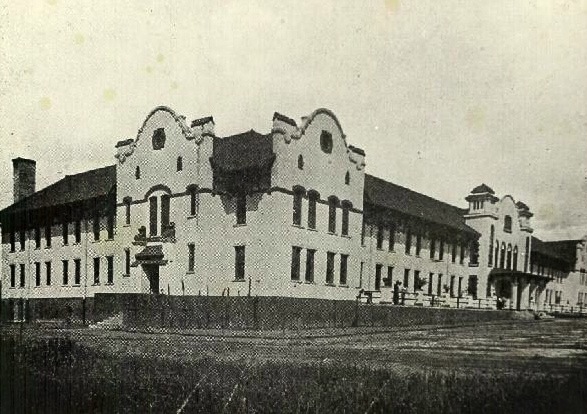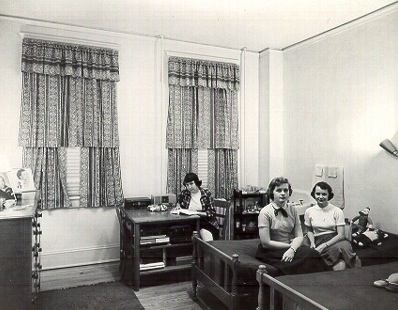History
 From its opening in 1913 as a normal college for women, with a two-year course in teacher preparation, it has grown to a thriving university of more than 10,500 students, offering degrees from the associate to the doctorate. As a regional university, Valdosta State is charged with meeting the professional and general educational needs of its south Georgia service area, which stretches from the Atlantic Coast to Alabama, encompassing forty-one counties and 31 percent of the land area of the state.
From its opening in 1913 as a normal college for women, with a two-year course in teacher preparation, it has grown to a thriving university of more than 10,500 students, offering degrees from the associate to the doctorate. As a regional university, Valdosta State is charged with meeting the professional and general educational needs of its south Georgia service area, which stretches from the Atlantic Coast to Alabama, encompassing forty-one counties and 31 percent of the land area of the state.
Founding
Th
Early Years
The school opened as South Georgia State Normal College in January 1913, with three college freshmen and fifteen subfreshmen, who attended a training school that prepared students for college-level work and provided a place of pedagogical experimentation for the college's students.
The early students were required to wear a school uniform and paid ten dollars per year for tuition and twelve dollars per month for board and laundry. Most came to be teachers and studied subjects from literature to physics to agriculture. In 1922 the school became a four-year college, and the legislature changed the name to Georgia State Woman's College (GSWC). By that year the school had grown to 402 undergraduates, and the training school to 108 students.
The financial hardships of the Great Depression brought major changes to GSWC. The training school, popular with the town from its inception, was ordered closed in 1933 by the chancellor, and the school was made a four-year liberal arts college. Teacher training was drastically deemphasized for five years or so.
During the tenure of GSWC president Frank Robertson Reade (1935-48), New Deal programs enabled the school to expand physically from three to seven buildings. The Powell Library, dedicated by first lady Eleanor Roosevelt, was a centerpiece of this construction. During World War II (1941-45), GSWC emphasized politics and science in its curriculum, and in 1943 the Bachelor of Science degree was added. Extracurricular activities centered on projects designed to aid the war effort, such as scrap metal drives, USO dances, a War Bond Scholarship campaign, and Red Cross activities. Moody Air Force Base, located about ten miles from campus, provided the male participants for many patriotic parties.
Valdosta State College
 Soon after Reade's retirement and his replacement by Ralph Thaxton (1948-66), the Board of Regents declared that in 1950 GSWC was to become a coeducational institution and would be renamed Valdosta State College. The coming of men to campus made immediate and lasting changes at Valdosta State. The elaborately costumed festivals came to an end early in the 1950s, supplanted by events planned to include both men and women. Within a few years, most of the extracurricular activities were male-dominated. In fact, by 1956 the men on campus outnumbered the women. Greek organizations were formed, with fraternities leading the way, and intercollegiate athletics became a part of campus life when the Rebels, an all-male basketball team, was formed.
Soon after Reade's retirement and his replacement by Ralph Thaxton (1948-66), the Board of Regents declared that in 1950 GSWC was to become a coeducational institution and would be renamed Valdosta State College. The coming of men to campus made immediate and lasting changes at Valdosta State. The elaborately costumed festivals came to an end early in the 1950s, supplanted by events planned to include both men and women. Within a few years, most of the extracurricular activities were male-dominated. In fact, by 1956 the men on campus outnumbered the women. Greek organizations were formed, with fraternities leading the way, and intercollegiate athletics became a part of campus life when the Rebels, an all-male basketball team, was formed.
The focus of the school broadened as well. Programs in premedical, pre-dentistry and prepharmacy education were added, and the sciences became more prominent. Business became a popular major after 1950, and the education department began expanding its secondary offerings. The college's tradition of attracting students from south Georgia, an area historically underserved educationally, continued.
Diversification
During Thaxton's tenure, the college integrated peacefully in 1963. Over the next decade, the college added African American students, faculty, and administrators, and Valdosta State continues to promote diversity and actively recruit minorities in all areas of campus life. In fall 2011 approximately 31 percent of the student body and 6.5 percent of the faculty were African American.
Thaxton retired for health reasons in 1966, and his successor, S. Walter Martin (1966-78), presided over a time of physical expansion of the school, including the construction of the Odum Library, the Education Center, the Fine Arts Building, the College Union, a science administration building, and five dormitories.
The student body grew, the Division of Nursing (now the College of Nursing & Health Sciences) was established, and many programs expanded, including those in graduate education.
When Martin retired in 1978, Hugh Coleman Bailey (1978-2001) assumed the post. Under Bailey, the school doubled in size, from about 4,500 to about 9,000 students. Numerous programs were added and existing courses upgraded. Throughout the 1980s the college established off-campus sites across south Georgia and began receiving state and federal grant funds to develop curricula and programs.
Valdosta State University
In 1993 the college became Valdosta State University (VSU), the second regional university in the University System of Georgia. VSU consists of five colleges (arts, arts and sciences, business administration, education, and nursing), a graduate school, and two divisions (aerospace programs and social work). To accommodate the rapid expansion of programs, in the 1990s a new building boom began, with careful attention given to maintaining the Spanish Mission style established in existing campus buildings. In 2001 VSU began offering a master of library and information science degree. In 2003 VSU offered a total of fifty undergraduate majors, twenty-three master's degrees, nine educational specialist degrees, and doctorates in education. In recent years the master of social work has been a growing program, as have master's degrees in public administration, nursing, business, and communication disorders.
VSU has established partnerships with area colleges and universities, offering courses on four two-year college campuses and two military bases and through distance education. It has an active international program and sponsors faculty exchanges on every continent in the world. Since becoming a university, VSU has virtually eliminated its remedial studies program and has raised its admission standards substantially.
In December 2001 Hugh Bailey retired after twenty-three years as president of VSU. He was succeeded by Ronald M. Zaccari, former president of West Liberty State College in West Virginia. Zaccari's administration began by focusing on strategic planning to strengthen the university in the twenty-first century. Despite the impressive growth of recent years, the school remains grounded in a concern for students' development and in meeting the educational needs of south Georgia. During Zaccari’s tenure, the campus embarked on a third “building boom” and this time the campus built “up” instead of out. The Zaccari years saw the completion of four dormitories, two parking decks, a huge new Student Union, and a new health center. Zaccari was followed in 2008 by Patrick Schloss who presided for two and a half years during a time of fiscal austerity. His leadership brought a focus on faculty scholarship and fiscal responsibility.
After a national search, Dr. William McKinney became VSU’s ninth president in July of 2012. Dr. McKinney's tenure saw the opening of the Health Sciences and Business Administration building, a 150,000 square-foot nursing and business facility that serves over 2,000 VSU students as well as the community through the Martin and Laura Lynn Miller Family Clinic. Dr. McKinney also led the way to nearly two dozen transfer agreements with community colleges across the country, allowing their students access to resources and programs at VSU while significantly increasing transfer enrollment. During his administration, Valdosta State University was able to offer in-state tuition to all residents of Alabama, Florida, and South Carolina, making Valdosta State a competitive choice for all students in the southern United States.
Following McKinney's three years of service, Dr. Cecil P. Staton began his tenure as interim president in July of 2015. In Staton's year as interim president of the university, an emphasis on building spirit and tradition led to new experiences for students, faculty, staff, and the community. The "Paint Valdosta Red" campaign encouraged members of the community to put aside differences in high school rivalries and support Blazer Athletics as a unified community. New "spirit marches" led the marching band, cheerleaders, Red Hots, and athletes through campus with a long trail of students, faculty, and staff following behind them to increase the excitement for home football games. Most memorable for many was a change in Spring graduation ceremonies. With the new single ceremony in Bazemore-Hyder Stadium at dusk, nearly 1,300 graduates heard a stirring commencement address from distinguished alumni and closed the celebrations with a fireworks show to remember.
In July of 2016, Dr. Kelli Brown assumed the role of interim president, and a search committee was commissioned by USG Chancellor Hank Huckaby to find VSU's next president.
In December 2016, Dr. Richard A. Carvajal was named the 10th president of Valdosta State University and began serving the institution on January 3, 2017.
如果
Portions adapted from a New Encyclopedia of Georgia article by Hugh C. Bailey and Deborah S. Davis.
Additional reading: Deborah S. Davis, Valdosta State University (Charleston, S.C.: Arcadia, 2001).
For additional information, visit Valdosta State University Archives and Special Collections.
About Valdosta State
- 1500 N. Patterson St. Valdosta, Georgia 31698
- Mailing Address
1500 N. Patterson St.
Valdosta, GA 31698 - Phone: 229.333.5800